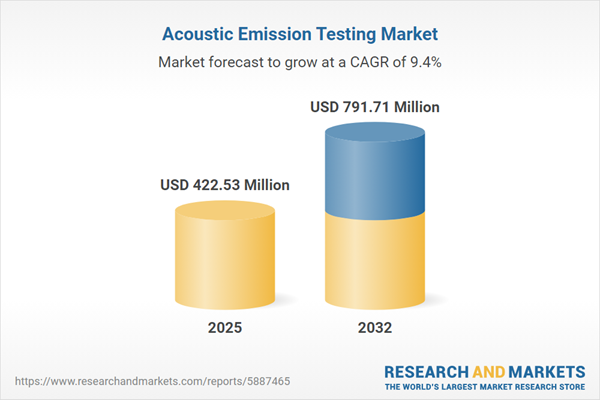Speak directly to the analyst to clarify any post sales queries you may have.
Acoustic emission testing is transforming asset management and compliance strategies, supplying actionable data for senior decision-makers focused on risk reduction and operational reliability across mission-critical sectors.
Market Snapshot: Acoustic Emission Testing Market
The global acoustic emission testing market is experiencing notable growth as manufacturers and infrastructure operators shift towards real-time asset monitoring and digital analysis tools. In 2024, the market stands at USD 386.55 million. By 2025, it is expected to reach USD 422.53 million, and by 2032, it will expand to USD 791.71 million, resulting in a robust compound annual growth rate (CAGR) of 9.37%.
Multiple drivers—including stringent compliance requirements, widespread adoption of digital maintenance solutions, and heightened pressure to prevent unplanned downtime—are accelerating this expansion. Key industries such as aerospace, automotive, energy, and manufacturing are deepening their investment in advanced testing methods to extend equipment life and align with evolving regulations.Scope & Segmentation of the Acoustic Emission Testing Market
This report provides an in-depth overview of the acoustic emission testing market, helping executives shape strategic investments with clarity on technology options, service offerings, and regional market dynamics.
- Component Types: Modular analyzers, standalone units, and both wired and wireless data systems address diverse monitoring and diagnostic objectives in different industries.
- Sensor Technologies: Fiber optic sensors and piezoelectric sensors enhance accuracy while performing in varied operational environments to support advanced defect detection strategies.
- Services: Consulting, failure analysis, preventive maintenance, asset assessments, and training—delivered onsite or remotely—improve asset durability and compliance confidence.
- Software Solutions: Analytics platforms, cloud and on-premises modeling, and comprehensive asset management tools facilitate predictive maintenance and robust risk oversight.
- Applications: Deployed across aerospace, automotive, energy generation, oil and gas, defense, and manufacturing to streamline operations and mitigate risk factors.
- End Users: Energy utilities, machine builders, petrochemical firms, defense organizations, and research institutions rely on these solutions for stringent quality assurance and regulatory alignment.
- Installation Types: Options include permanent systems for enterprise-wide oversight as well as portable setups for focused, site-specific monitoring requirements.
- Techniques: Parameter-based methods and waveform-based analysis augment precision in fault detection and support ongoing maintenance improvements.
- Regions: The Americas, Europe, Middle East, Africa, and Asia-Pacific each present specific adoption patterns and compliance demands. Leading growth markets include the United States, Canada, China, Germany, India, Japan, and Australia.
- Leading Companies: Prominent providers include Mistras Group, Olympus Corporation, Baker Hughes Company, Eddyfi Technologies, Zetec, Vallen Systeme, Proceq, Sonatest, Intertronics NDT, and LORD MicroStrain Sensing Systems.
Key Takeaways for Senior Decision Makers
- Adopting acoustic emission testing enhances predictive asset management, enabling organizations to improve equipment reliability while reducing risks related to service interruptions.
- Continuous advancements in sensor technology and wireless monitoring streamline real-time asset data collection, ensuring minimal disruption to operations during inspections or diagnostics.
- Strategic integration with broader asset health platforms empowers teams to deploy resources more effectively, achieve scheduling efficiencies, and limit downtime during maintenance.
- Allocating resources to workforce training is crucial, ensuring technical teams can adapt to new diagnostic methodologies and adhere to changing compliance standards.
- Customized services are tailored to address local regulatory frameworks and market-specific requirements, fostering trust and stronger compliance posture across global operations.
- Flexible delivery models, including remote and onsite options, give organizations the agility to respond to sectoral trends and evolving customer needs.
Tariff Impact on Supply Chains and Cost Structures
Recent shifts in United States tariff policies have influenced sourcing and distribution strategies within the acoustic emission testing market. Many organizations are increasing domestic sourcing, diversifying suppliers, and optimizing pricing structures to stabilize equipment supply, avoid labor disruptions, and uphold operational continuity amid global trade changes.
Methodology & Data Sources
The insights in this report are grounded in direct interviews with industry experts, triangulated with validated market data and peer-reviewed studies. This comprehensive approach ensures executive audiences receive actionable, reliable analysis for planning and decision-making.
Why This Report Matters: Strategic Outcomes & Benefits
- Enables senior leaders to pinpoint high-value market segments and invest in technologies that foster operational improvement and competitive positioning.
- Equips procurement and operations professionals with early insight into emerging supply chain vulnerabilities tied to regulatory shifts worldwide.
- Provides recommendations for reinforcing compliance, catalyzing innovation, and supporting sustainable investment strategies aligned with ever-evolving market demands.
Conclusion
Advanced acoustic emission testing solutions provide senior management with vital insights to manage change, enhance resilience, and safeguard organizational value across dynamic industrial landscapes.
Additional Product Information:
- Purchase of this report includes 1 year online access with quarterly updates.
- This report can be updated on request. Please contact our Customer Experience team using the Ask a Question widget on our website.
Table of Contents
3. Executive Summary
4. Market Overview
7. Cumulative Impact of Artificial Intelligence 2025
Companies Mentioned
The companies profiled in this Acoustic Emission Testing market report include:- Mistras Group, Inc.
- Olympus Corporation
- Baker Hughes Company
- Eddyfi Technologies Inc.
- Zetec, Inc.
- Vallen Systeme GmbH
- Proceq SA
- Sonatest Ltd.
- Intertronics NDT Ltd.
- LORD MicroStrain Sensing Systems, LLC
Table Information
| Report Attribute | Details |
|---|---|
| No. of Pages | 185 |
| Published | October 2025 |
| Forecast Period | 2025 - 2032 |
| Estimated Market Value ( USD | $ 422.53 Million |
| Forecasted Market Value ( USD | $ 791.71 Million |
| Compound Annual Growth Rate | 9.3% |
| Regions Covered | Global |
| No. of Companies Mentioned | 11 |









